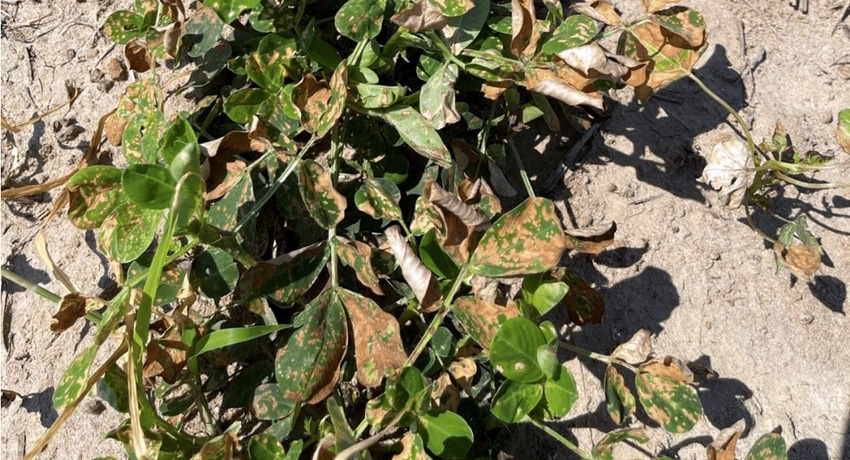June 25, 2021

Every growing season is different and unique, this year is not different. Since late spring, we experienced very wet condition until mid-May, then very dry, then very wet again. It is almost like after a blink of eye, field condition is totally switched from one end to the other. Many cotton and peanut fields in south Alabama were planted during the dry spell, growers were concerned about their residuals behind planter might be wasted.
The concern is real because I have seen Palmer amaranth and sicklepod broke though almost any type of herbicides I put out behind planter in my research plots. Without adequate and timely rainfall, they are not helping weed control much. Before growers have time to deal with escapes from PRE application, the intense rainfalls in the last several days may throw more people off the 'weed control bus' as they cannot get back to their fields for a while.
Palmer, grasses, sicklepod and other weeds are fully utilizing this period to grow as fast as they can. By the time people can spray them, they might be too big to control by any herbicides. This is an unfortunate situation that someone will need to deal with. I received several questions recently about dealing with large weeds in peanut. We don’t have Liberty, Dicamba, 2,4-D and Roundup options in peanut since it is not a GMO. So do not expect spraying peanut crop without causing any crop injury and leaf burn in the real world.
The most effective treatment to take out bigger-than-ideal weeds is still the most injurious one to peanut, and that is Gramoxone. I admit leaf burn caused by Gramoxone can be scary and it is not for the faint of heart. Someone who gets nervous easily may black out in field after seeing how bad peanuts are burnt.
However, if you are behind and you have a bunch of tough weeds over one foot tall in your peanut fields, you either need to live with leaf burn for a few days or live with those weeds for the rest of the season unless you have a labor crew to hand pull every weed up. When soil moisture is not a limiting factor and sunshine is also available, injured crop usually grow out of Gramoxone leaf burn in 10-14 days without incurring yield loss. It takes them longer to recover from herbicide injury under hot and dry conditions.
If you decide to spray Gramoxone to clean up your fields after all these rains, here are a few things to consider:
For 2lb Gramoxone, do not use more than 16 oz. 12 oz is usually what I recommend. For 3lb Gramoxone, use 8-10 oz per acre. A NIS surfactant is needed for better droplet retention. Spray with medium droplet size and minimum 15 gal/A output under sunny condition work the best for weed control. Do not use crop oil surfactant.
Tank mix Storm or Basagran with Gramoxone can safen leaf burn and visual injury by 10-15%. This practice will also enhance morning glory and nutsedge control.
Tank mix 2,4-DB at 16 oz/A for better Palmer, coffeeweed and sicklepod control.
If you want to add a residual herbicide, options are Dual Magnum or generic at 16 oz/A, Warrant at 2.5 pt/A, Zidua SC at 3 oz/A, or Outlook at 13 oz/A. These Group 15 residual herbicides provide extended Palmer and annual grass control.
Cut-off date for Gramoxone is 28 days after cracking, which is somewhere around 32-35 days after planting. If your peanut is older than 35 DAP, use Cobra, Storm or Ultra Blazer for Palmer control instead. Gramoxone is too injurious on older peanut that can lead to significant yield loss.
Cobra, Storm, Aim and Ultra Blazer belong to the PPO herbicide family. This family also includes other famous herbicides such as Valor, Reflex and Goal. A common attribute for this family is they all burn crops and cause injury to some extent. Our research data from the last a few years indicated Cobra, Storm and Aim should not be sprayed with crop oil and more injury is expected under hot and dry conditions. Excessive leaf burn at 60 DAP has cause yield loss in our previous studies.
However, the concern is much lower when moisture is abundant and peanut is younger than 60 DAP. In fields where Palmer amaranth is not a main issue but sicklepod, morning glory and annual grasses dominate. My recommendation is Cadre 3 oz + 24DB 16-24 oz + a Group 15 herbicide such as Dual, Warrant, Zidua or Outlook. Addition of half rate of Strongarm (0.225 oz/A) to this mix can enhance morning glory, nutsedge, bristly starbur and tropical spiderwort control. This tank mix is not so dependent on sunlight, so spraying under cloudy conditions is acceptable unlike the leaf burn herbicides.
Li is a weed specialist with the Alabama Cooperative Extension System.
Read more about:
GramoxoneYou May Also Like




